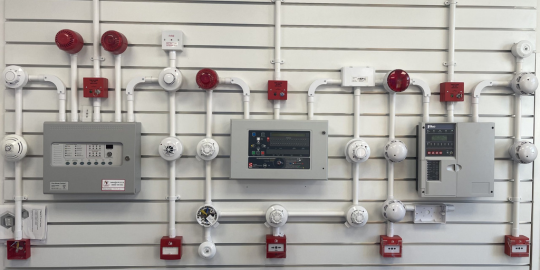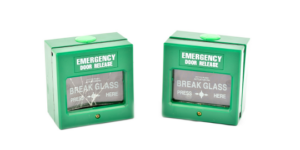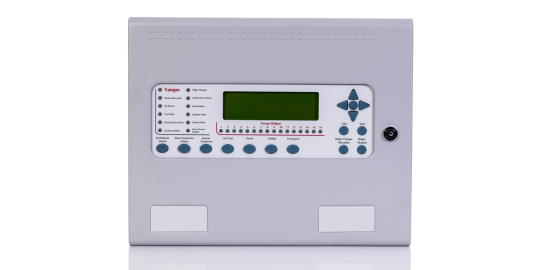Introduction to BS5839 Fire Alarm Systems
BS5839 fire alarm systems legislation is a British Standard that provides UK businesses with guidance when managing their fire alarm systems. Therefore, this legislation covers any requirements for design, installation, commissioning and maintenance. In effect, it aims to ensure the detection and timely notification of fire incidents. Thus, enhancing the safety of occupants and minimising property damage. We can measure the level of protection for your business based on the introduction of different BS5839 fire alarm systems categories and grades. This is based on the fire alarm system’s intended purpose and performance requirements. In short, the grading system emphasises the importance of a comprehensive and reliable fire alarm system that aligns with your specific needs.
When purchasing a fire alarm system, we must consider:
- Size and complexity of the building.
- Level of fire risk.
- Need for different levels of alarm response.
By following the guidelines outlined in BS5839, stakeholders can ensure compliance with legal and regulatory requirements. Let’s implement an effective fire safety strategy together. OHEAP can ensure your system is properly designed, installed and maintained.

Need A Fire Safety Risk Assessment?
Scope and Objectives of BS5839
Scope:
BS5839 is a British Standard that provides guidance for fire detection and fire alarm systems in buildings. In fact, it covers a wide range of premises including residential, commercial, industrial and public buildings. With the aim of ensuring adequate fire safety measures are in place.
Objectives of:
1) Detecting Fire and Providing an Early Warning:
Firstly, the primary objective of BS5839 fire alarm systems is to facilitate the early detection of fires. We can do this through the use of reliable and effective fire detection systems. In fact, by detecting fires at their early stages, occupants can:
- Be promptly alerted.
- Evacuate safely.
- Reduce the likelihood of any potential injuries or fatalities.
2) Protecting the Property and its Contents:
Secondly, we must protect the property and its contents by enabling the timely response of emergency services. In addition to this, we can implement appropriate fire suppression measures. The BS5839 fire alarm systems standard provides corporate guidelines for:
- Alarm signalling/Alarm Receiving Centre (ARC):
- Monitoring.
- Control systems.
- Ensuring a coordinated and efficient response to fire incidents.
3) Ensuring Regulatory Compliance:
BS5839 aims to establish a framework that aligns with relevant regulations, codes and legislative requirements. In addition, compliance with the standard helps building owners, managers and occupiers meet their legal obligations. We must provide a safe environment for employees and visitors.
4) The Design and Integration of Your Fire Safety System:
The standard outlines core principles for the design, installation, commissioning and maintenance of fire alarm systems. Utilising this guidance, we can understand the importance of considering a building’s layout, occupancy, fire risks and potential environmental challenges. In addition, BS5839 promotes the integration of fire alarm systems with other safety systems. This will enhance overall emergency response.
5) Improving Your False Alarm Management:
Lastly, addressing the issue of false alarms is another objective of BS5839 fire alarm systems. Using this standard, we have guidance on selecting and positioning our fire detection devices to minimise false alarms. Simultaneously helping prevent unnecessary disruptions and maintain the credibility and effectiveness of fire alarm systems.
Overall, the scope and objectives of BS5839 aim to establish best practices. Remember, these guidelines are for the design, installation and maintenance of fire alarm systems. We must ensure the safety of our occupants and the property while promoting regulatory compliance.
BS5839 Regulatory Compliance and Standards:
BS5839 is a British Standard that outlines the requirements and recommendations for fire alarm systems. We can apply this standard to various types of buildings. In the UK, regulatory compliance with BS5839 fire alarm systems is crucial to ensure the safety of occupants. We have compiled some key aspects below that are related to regulatory compliance and standards within BS5839:
1) BS5839 Fire Alarm Systems Legal Framework:
Firstly, compliance with BS5839 helps UK organisations meet their legal requirements. These standards are set forth by regulatory bodies, such as:
- Building Codes.
- Fire Safety Regulations.
- BAFE Fire Safety Register.
- National Security Inspectorate.
- Building Safety Regulator.
Adhering to the standard demonstrates a commitment to providing a safe environment and mitigating the risks associated with fire incidents.
2) Certification and Third-Party Approval:
Secondly, BS5839 compliance may be required to obtain certifications or third-party approvals. For example, those provided by independent certification bodies or regulatory authorities. These certifications validate that the fire alarm system meets the necessary standards, thus, providing assurance of its reliability and effectiveness.
3) BS5839 Fire Alarm System Categories and Grades:
Thirdly, BS5839 fire alarm systems can be split into different categories. For example, categories M, L and P are based on the level of protection required. Whereas grades A, B, C, D, E and F are based on the system’s reliability and performance. Compliance involves selecting the appropriate category for your business. This grading is based on the specific application and level of fire risk identified for a particular building or premises.
4) Equipment Standards and Testing:
BS5839 provides guidance for the selection, installation and testing of fire alarm system components. Regular testing and maintenance of the system are essential to ensure ongoing compliance and optimal performance.
5) Documentation and Record-Keeping:
Lastly, to comply with BS5839, we must maintain accurate and up-to-date documentation. For example, design specifications, installation records, test reports, maintenance logs, and any modifications or upgrades. Proper documentation demonstrates compliance and assists in system management, auditing, and future maintenance activities.
By adhering to BS5839 fire alarm systems regulatory compliance and standards, organisations can ensure the effective implementation and operation of fire alarm systems. Thus promoting occupant safety, regulatory compliance and the reduction of fire-related risks.
BS5839 System Categories and Grades
The introduction of BS5839 fire alarm systems categories and grades aids when classifying a fire alarm system. For example, based on its intended purpose, we can assign performance requirements. Additionally, categories and grades help determine the level of protection needed for a specific building or premises. Here is an overview of the system categories and grades within BS5839:
System Categories:
- Category M Manual systems where the detection of fire is reliant on human observation. Thus, no automatic fire detection or alarm initiation.
- Category L5 Systems are designed for the protection of specific parts of the building, such as high-risk areas. Early detection is required but not throughout the entire premises.
- Category L4 Systems are designed to provide coverage in defined areas or zones. Anywhere the risk of fire is present, therefore, ensuring early detection and warning.
- Category L3 Systems are designed to provide coverage throughout all areas of the building. Ultimately, providing early detection and warning capabilities.
- Category L2 Systems are designed for life safety, covering all areas of the building. For example, we can target specific fire hazards. The aim is early detection and a quick fire evacuation.
- Category L1 Systems are designed for life safety and property protection. L1 systems provide the highest level of coverage with automatic fire detection and rapid response throughout the building.
System Grades:
The system grades within BS5839 determine the reliability and performance of the fire alarm system components:
- Grade A: This is the highest grade and offers the highest level of protection. Grade A systems typically have fully redundant components and multiple backup power supplies. In fact, they are designed to provide continuous monitoring and coverage throughout the premises, including detection, notification and control.
- Grade B systems provide a high level of protection, but they may not have the same level of redundancy as Grade A. Generally, these systems are designed to cover critical areas or sections of a building. Also, they are suitable for applications where a high level of protection is required, but not necessarily required throughout the premises.
- Grade C systems offer a basic level of protection. Often, they have limited coverage and will typically consist of standalone detectors and alarms. In brief, no centralised control panel. We supply these systems to smaller buildings or individual units.
- Grade D systems are used in residential buildings and offer a basic level of protection. They consist of standalone battery-powered smoke detectors that provide local alarms but are not interconnected.
It’s important to carefully assess the specific requirements and level of fire risk in a building to determine the appropriate system category and grade. Compliance with the designated category and grade ensures the implementation of a fire alarm system that meets the necessary performance and safety standards.
Fire Detection Devices and Equipment
Smoke Detectors:
Smoke detectors are designed to detect the presence of smoke particles in the air. They can be categorised into various types. For example, ionisation smoke detectors, photoelectric smoke detectors and multi-sensor smoke detectors. Generally, these devices are strategically placed throughout the building to provide early warning of fire.
Heat Detectors:
Heat detectors are designed to sense increases in temperature and are suitable for areas where smoke detectors may not be suitable due to high levels of dust, fumes or steam. There are different types of heat detectors, such as fixed temperature heat detectors and rate-of-rise heat detectors, each with its own detection mechanism.
Flame Detectors:
Flame detectors are specialised devices that detect the presence of flames through optical sensors. They are typically used in environments where fast flame detection is essential, such as areas with flammable liquids or gases.
Manual Call Points:
Manual call points are often referred to as fire alarm call points or break glass units. These devices allow individuals to manually activate the fire alarm system by breaking the glass or pressing a button. We place these products in easily accessible locations throughout the building.

Sounders and Beacons:
Sounders and beacons provide audible and visual alerts, respectively, to notify occupants of a fire alarm activation. These devices are typically installed in areas where occupants may have difficulty hearing or seeing the standard fire alarm sounders.
Control and Indicating Equipment (CIE):
CIE serves as the central control unit for the fire alarm system. The CIE receives signals from the detectors and other fire alarm system devices and controls the activation of sounders or beacons. CIEs can also provide visual indications of the system’s status and any fault conditions.
It’s important to note that BS5839 provides guidelines on the selection, installation, positioning, and maintenance of these devices and equipment to ensure their proper functioning. Compliance with these guidelines helps ensure reliable and effective fire detection within a building or premises.

Conclusion
In conclusion, BS5839 fire alarm systems are a comprehensive British Standard. The standards aim to provide essential guidance and requirements for the design, installation, commissioning and maintenance of a fire alarm system. By adhering to the guidelines outlined in BS5839, stakeholders can ensure compliance with legal and regulatory requirements. Often while implementing an effective fire safety strategy.
The BS5839 fire alarm systems standard covers a wide spectrum of components. For example, system design, product selection, wiring, control equipment and testing procedures. We must consider factors such as the size and complexity of the building and the level of fire risk. In fact, the need for different levels of alarm response is crucial.
The primary objectives of BS5839 are to facilitate early fire detection. We do this by providing timely notifications of fire incidents and ensuring that all life is protected within the property. By achieving these objectives, employers will meet the regulations necessary to run a business.
Overall, BS5839 fire alarm systems serve as a valuable resource for ensuring the safety of occupants and minimising property damage in the event of a fire. By following the guidelines and requirements outlined in the standard, stakeholders can create and maintain effective fire alarm systems. We must focus on early fire detection and timely notifications. Ultimately, let us enhance overall fire safety.